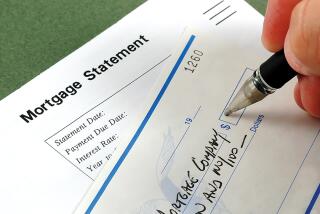Federal Reserve reports $1-trillion increase in homeowners’ net equity
Reporting from Washington — With all the grim news about underwater mortgages and rising foreclosures, you might be surprised to learn that a bellwether measure of the national housing market — homeowners’ equity stakes — has been on the rebound.
It hasn’t received much publicity, but the Federal Reserve’s latest “flow of funds” statistical report on the nation’s finances found that homeowners’ net equity holdings have increased from $5.9 trillion during the first quarter of 2009 — the hard bottom of the recession cycle — to just under $7 trillion through the second quarter of 2010 ended June 30.
Big numbers, but what does a $1-trillion increase in homeowner equity really mean? How could the Fed’s widely accepted measurement have jumped 17.1% in just 15 months? Home prices may be up modestly in some parts of the country over that period — even by double digits in a handful of California’s most volatile markets. But those percentage gains are being measured against the shell-shocked lows of late 2008 and early 2009. Statistically, even a modest increase in depressed median prices can look impressive.
If home equity, as measured by the economists at the Fed, has rebounded so vigorously, why haven’t most of our own personal equity holdings haven’t done anywhere near as well? Is the Federal Reserve’s equity number relevant to owners and prospective buyers?
The simple answer is this: The Fed’s rising home equity finding is mainly good news for residential real estate, but the increase is not attributable solely to positive events. The Fed makes its basic calculation the same way most homeowners would: You subtract your total mortgage debt from the estimated market value of your real estate.
The remainder — if there is one — is your net equity. The Fed has access to the mortgage debt holdings of banks and non-bank lenders, and uses a variety of governmental and private real estate data sources to arrive at quarterly home values across the country.
But here’s where things get a little complicated. The types of data that flow into those massive debt and home value numbers include variables you might not think about when you tally your own equity. Calvin Schnure, a former Fed economist who worked on “flow of funds” reports and now is the director of economic analysis at Freddie Mac, says the national mortgage debt statistic is pushed downward by principal reductions and foreclosures by lenders — signs of homeowner distress — but also by faster pay-downs of mortgage debt balances.
Each of these trends has been strongly underway during the last year. For one illustration of faster pay-downs, Schnure noted in an interview that 22% of all refinancings of Freddie Mac loans in the most recent quarter involved a “cash in,” in which homeowners bring money to the table to reduce their total mortgage burden.
American consumers have been deleveraging — cutting debt — across the board since the onset of the recession, Schnure said. This is a positive trend, he said, because “household balance sheets are getting better,” in stark contrast to the credit gluttony that characterized the boom years. Also, some lenders are weaning borrowers off certain forms of high-balance credit — restricting home equity lines, for instance — and that further reduces mortgage debt outstanding.
On the real estate side of the ledger, Schnure said home price appreciation has pushed up homeowner equity holdings, accounting for roughly one-third of the $1-trillion gain in the Fed’s calculations. Some of the increase is also attributable to home improvements and remodeling investments.
Doug Duncan, chief economist at Fannie Mae and a longtime analyst of real estate and mortgage trends, said still another factor pushing up equity totals was the recent growth of all-cash sales of homes “where, of course, equity is always 100%.” On top of that, about one-third of all homeowners have paid off all mortgage debt.
Now back to the original question: What’s the significance of the Fed’s steadily rising home equity number for the average homeowner? There’s no dispute that a 17% increase is a positive sign. Home values nationwide no longer are on the downgrade, and household debt loads are moderating.
None of this offers much solace to people still stuck with underwater mortgages or who lost their homes to foreclosures. But for just about everybody else who cares about home real estate, the latest Fed numbers suggest that the equity crash probably is over and that a rebuilding — with healthier credit habits — is underway.
Distributed by Washington Post Writers Group
More to Read
Inside the business of entertainment
The Wide Shot brings you news, analysis and insights on everything from streaming wars to production — and what it all means for the future.
You may occasionally receive promotional content from the Los Angeles Times.










